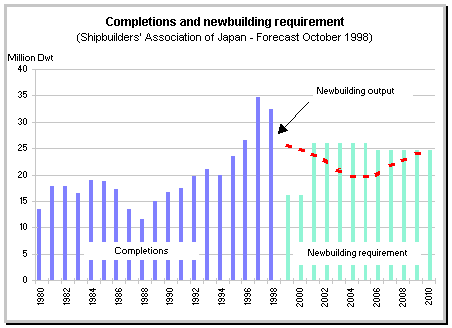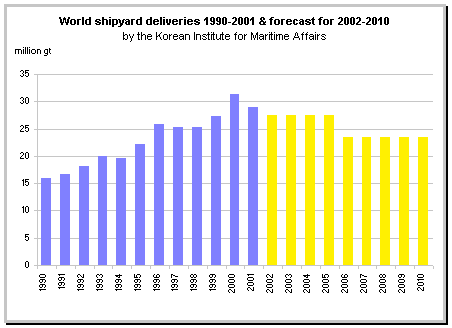
|
|
|
The two Finnish shipyards Aker-Finnyards
and Kvaerner-Masa have remained focused on the production of ferries and
ro-ros for one and cruise ships for the other. But neither of these
yards took on any orders this year and the Finnish orderbook has gone
from 1,000,000 to 614,000 gt.
|
|
|
|
The two shipyards Odense and Orskov have
kept to their respective areas. Odense is believed to have taken an
order for six containerships of 9,600 teus and Orskov continues its
production of offshore units
|
|
|
|
The existing Dutch orderbook has remained stable compared to last
year with 555,000 gt. It has the distinction of an important production
of small-sized ships, generally less than 10,000 dwt and often very
specialised, which has been so far the best insurance for the Dutch
shipbuilding industry, given the lack of competition from other European
countries.
But Dutch shipyards will have to learn to work without the direct
subsidies and without the benefits of the Dutch tax incentives, which
have encouraged the creation in the 90's of an important fleet of
ships generally placed with local yards
|
|
|
|
The orderbook of Norwegian shipyards has kept steady with nearly
150,000 gt. It is made up mainly of units for the offshore oil industry.
Norwegian shipyards have acquired an impressive know-how and benefit from
a strong domestic demand.
The Aker group is in the process of overtaking the Kvaerner group who,
with 13 shipyards, had dominated the European shipbuilding scene during
the 90's. Today the Aker group owns 10 shipbuilding sites ranging from
Norway, Finland, Germany, to Romania.
|
|
|
|
|
Poland has benefited largely from the demand and the full occupancy of
Korean shipyards at the end of 2000. During 2001 the existing orderbook
for Polish shipyards reached an historic national record with more than
2,900,000 gt (132 ships). Poland takes fourth place in the world. German
owners have ordered an important series of containerships totalling 49
ships for nearly 1,700,000 gt in the third quarter 2001, compared with 64
containerships in Korea for 3,400,000 gt and 34 units in Germany for
700,000 gt.
But Polish shipyards are today highly exposed to the containerships
market and to a certain extent their future is linked to that of their
clients. They should be looking for substitute orders. Delayed delivery of
a series of chemical carriers being constructed at Szczecin shows that
diversification also carries risks.
Poland can be happy at the E.U.'s decision not to reintroduce
subsidies for the shipbuilding industry. She can hope to attract European
owners by taking advantage of her geographical proximity.
|
|
|
As with Poland, Croatia has substantially benefited from the demand
and the saturation of Korean shipyards. During 2001, the orderbook of
Croatian yards also achieved an historic national record with more than
1,632,000 gt (June 2001) compared to 973,000 gt (December 2000).
All the Croatian shipyards, Split, Uljanik, 3 Maj, and Trogir are
full up till end 2004, early 2005. The majority of their production
comprises product tankers and chemical carriers.
The Kraljevica shipyard, which has not had an order since 1992,
signed up two bitumen carriers of 9,000 dwt.
Croatia can also be content that the E.U. did not reinstate its
subsidies for shipbuilding, and like Poland hope to benefit from its
close proximity to European owners.
But it is also confronted with other problems. It will need to invest
in its production base to maintain a competitive edge and keep its
qualified staff, who is more and more attracted to the neighbouring
shipyards of western Europe.
|
|
United-States
|
|
The American shipbuilding industry continues to progress and now
occupies the eighth position in the world rankings with over one million
gross tons at end 2001. Ten years earlier, its orderbook was barely
50,000 gt.
These results would not have been possible without the introduction
of favourable financing (Title XI), the benefit of the Jones Act which
obliges ships employed on coastal traffic to be built in domestic
shipyards, and without the dynamism of the U.S. offshore oil industry.
|
| Prospects
|
|
|
2002 looks like being a particularly difficult
year. Much will depend on the depth of the new crisis. However opinions vary.
The forecast for deliveries made in October 1998 by the Association of
Japanese Shipbuilders was relatively pessimistic for the years 1999 and 2000
with a little over 26 million dwt against 40 and 44 million dwt actually
achieved.

|
Those of the Korean Institute of Shipping
Affairs, more recent (January 2001), are equally pessimistic. Are they
therefore more realistic? Only the future will tell.

|
|
Experience shows that forecasts are often too
glib with little consideration for the actual fluctuations and volatility
in the past. They are therefore bound to contain errors.
During the 90's the world orderbook and the delivery of newbuildings
always grew a little each year. There were occasional moments of doubt.
But they were immediately overcome by new concessions made on sale's
price. In this respect 1999 and 2000 were exceptions, to the extent that
demand for newbuildings which was extremely strong was met by a very
modest price rise.
Despite current pessimism, it is by no means unlikely that a rebound
after 2002 can be expected. The capacity of the market to pick itself up
after the Asian crisis of 1997-1998 was quite remarkable and experience
shows that with the cycles in industry, the more they are intense, the
shorter they are.
This rebound could come from an economic revival and from an increase
in demolitions.
But it is clear that during 2002 the volume of new orders should be
lower than that of 2001 which will have the effect of causing a further
deterioration in the price of these orders.
Shipbuilding is a relatively atypical industrial activity. Contrary to
numerous other industrial sectors, which do not hesitate to reduce their
production capacities when confronted with lower demand, either by closing
down plants or by reducing activity, shipyards have sought throughout the
90's to improve their productivity and their competitiveness by an
increase in production and, at the slightest sign of weakening demand, by
lowering their prices to attract new orders.
Excluding devaluation of the majors shipbuilding countries'
currencies (yen, won, yuan) to the dollar, any such lowering of prices in
dollars should be very difficult to grant for the following reasons:
- Current prices are already extremely low, near to the levels
obtained in 1999 following the Asian crisis.
- Ships are improving in performance and must meet increasing legal
restrictions, thus in principle are more expensive to build.
- The Asian crisis caused a change in behaviour especially in Korea.
What was possible before is no longer the case. The Chaebols have
broken up and it is now impossible to expect that losses of one
activity can be subsidised by the gains of another.
- Shareholders and financial analysts are pushing the industrial
conglomerates to spin off their different activities to obtain a more
transparent statement of their accounts.
Shipyards could hope to obtain some price reductions on raw materials
and equipment they use under economic pressure. They can also hope that
prevailing low interest rates will act as a strong incentive.
However the different shipbuilding areas do not have the same forces to
face this new crisis.
- European shipyards seem to us particularly vulnerable as they have
just lost the benefits of their shipbuilding subsidies. In addition
the exchange rate between the euro area countries versus the dollar
has recently enjoyed favorable levels which have not been seen for the
last 15 years. Production is dispersed over several countries,
shipyards, and building sites, leaving little room for consolidation
or economies of scale. Their production is also very narrowly spread
and substitute orders, which are a form of diversification, are less
easily undertaken and perhaps more risky. An increase of orders in
euro prices could possibly reverse this tendency.
- Korean shipyards appear to be better placed. They have a
considerable backlog of orders to allow them to bide their time. They
benefit from important economies of scale. They can decide to shut
down one or more docks if necessary. The won remains closely linked to
the dollar, which is the money of reference. Thanks to these
advantages they can also hope to capture a number of orders for
standard vessels or more sophisticated ships which would have gone to
European shipyards and thus gain market shares.
- Japanese shipyards seem to us equally well placed. Consolidations
are certainly easier to achieve within a nation rather than a
continent. Numerous Japanese shipyards are multi-site and regroupings
and rationalisations can be easily done. The yen remains weak and
allows Japanese yards to seduce opportunistic owners. Japanese
shipyards can also count, as they have always been able to do, on the
support almost unconditional of domestic shipowners.
- The low cost of Chinese manpower linked to a very modern
infrastructure should in principle guarantee a competitive advantage
over their two Asian rivals ' the Koreans and the Japanese. In the
price war that is looming, it would appear that the Chinese shipyards
have a considerable advantage, even if it takes more man-hours to
build a ship of the same specifications. They can also count on their
domestic owners and on the pressure of the Chinese government to
encourage owners to buy and build in China. Nonetheless the fixed
exchange rate of the yuan to the dollar and the reduced commercial
reactivity already seen in 1998 in a dropping market, could be a
handicap to these shipyards in 2002.
|
Shipping and Shipbuilding Markets in 2001
I N D E X
|